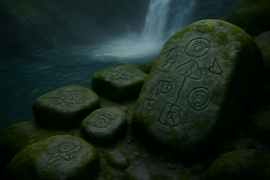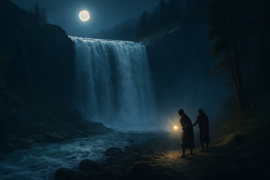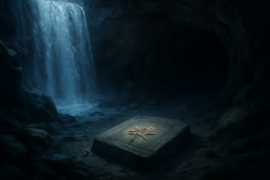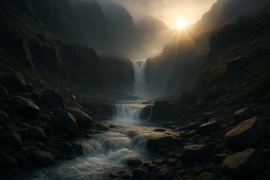Introduction
The morning sunlight filtered through the dense canopy above, painting shafts of gold onto slick rocks and swirling mist at the base of Kahoos Falls. The falls thundered with a voice as old as the mountains, and every drop of water that splashed against stone carried the weight of countless tales. I’d heard the stories in the small mountain town of Cedar Hollow, where the wooden porches creaked with age and the porch lights dimmed at midnight out of respect—some said fear—of the cursed cascade downstream. They said no one who dared to cross Kahoos ever returned unchanged. Those who made it back told of whispering shapes in the mist, of phantom footprints that led them astray, and of a sorrowful lament that echoed through the ravine when the sun dipped below the ridge.
I approached the falls by way of a narrow trail, the damp scent of moss and pine needles heavy on the breeze. Every step felt laden with history and warning; every rustle of leaves seemed to murmur caution. Locals clasped their hands when I asked about the curse—some shook their heads in fatalistic resignation, others crossed themselves, urging me to abandon any thought of crossing. My companion, a local guide named Eliza, carried only a lantern and a look that blended curiosity with dread. As we followed the riverbank, we passed half-buried relics—remnants of campsites and torn blankets long forsaken by travelers who’d fled in panic.
The roar of the waterfall grew louder, drowning out our whispered conversation. Mist clung to our jackets, chilling us to the bone. Under the rainbow arcing between churning currents, I glimpsed stones carved with strange symbols—spirits’ signatures, the townsfolk believed—meant to seal the spirit’s wrath. I inhaled deeply, steeling my nerves. The air tasted of ancient water and raw earth, and I knew that beyond the foaming lip of the falls lay the point of no return.
Eliza paused at the brink of the cascade, her lantern’s glow casting trembling patterns on the swirling water. “They say those who cross hear a lullaby in the noise,” she said, voice low. “A voice calling them deeper, offering safety on the other side—but it’s a trap.”
I nodded, heart pounding in my chest like a drumbeat born of challenge and chance. The river offered no mercy, no safe passage. Still, the truth beckoned. I stepped forward, and the granite edge slid beneath my boots with a wet rasp. The mist enveloped me, a living veil hiding horrors and hope alike. With one last breath, I would press my luck against the oldest curse in Cedar Hollow—and face the spirit that guarded Kahoos Falls.
Origins of the Curse
Long before the settlers arrived in the Appalachian foothills, the site of Kahoos Falls was a sacred place for an indigenous people whose name is now lost to time. They believed the waters were the tears of a river goddess betrayed by her mortal lover. On moonlit nights, their shamans would call upon her mercy in ceremonies held by firelight, weaving prayers into dreams that drifted downstream.

But one fateful autumn, a traveling hunter found refuge near the falls. Driven by need and desperation, he broke tradition: he crossed the roaring waters at their narrowest point, seeking game on the far bank. Witnesses claimed they saw him wobble on a moss-covered stone, his face awash in lantern light, glowing ghostly against the spray. Then, without warning, the river caught him. He vanished beneath the waves, and all that remained was his lantern, bobbing on the currents like a lost soul.
The next morning, the hunters discovered the lantern snagged on a jagged rock below the falls. It flickered softly despite having no source of fuel. The tribe took it as an omen—an act of sacrilege that invited the goddess’s rage. They carved glyphs into the stones around the fall’s lip, binding her anger to those daring enough to cross. Those who attempted to break the seal found their footfalls echoed by unseen steps behind them, and felt a sorrowful breeze urging them back.
Centuries later, pioneers settled along the river. They fished these cold waters but never strayed beyond the safe shallows. A local diary from 1842 tells of a wagon driver named Samuel Holt, who tried to ferry his goods across the raging rapids. Holt’s party watched in horror as the wagon tipped, spilling crates of supplies into the torrent. Holt tried to swim for safety, but the river squeezed him in its endless embrace. Rescuers found only one shoe on the bank and a fleeting whisper in the mist that chilled them deeper than the mountain wind.
Word of these calamities spread through Cedar Hollow and beyond. Some dismissed it as folklore for superstitious minds; others swore they’d felt a chill at the river’s edge, heard a distant lament in the current. They said the river goddess’s sorrow was woven into every bubbling eddy, so that any mortal who crossed risked being lost to her grief forever. To this day, the glyph-lined stones at the brink stand as mute sentinels—reminders of a promise broken and a curse that endures.
Attempts and Aftermath
Over the decades, outsiders have tested the curse, each encounter adding another story to the ever-growing tapestry of terror. In 1923, a traveling salesman named Martha Quinn pitched a makeshift campsite on a gravel bar just upriver. She saw a chance to photograph the falls at dawn, imagining her images would grace city magazines. The sky burned with shades of peach and lavender when she climbed onto a slick boulder to capture the perfect angle. Just as she focused her lens, a low song rose from the depths below—a delicate, mournful melody that drew her forward.

Martha remembered little after the first notes of the lullaby. Her final journal entry described slipping stones, dizzy heights, and water clawing at her ankles like unseen hands. She awoke two days later in Cedar Hollow, miles from her campsite, with no sign of camera or carriage. The only proof that she’d been there was a single photograph left behind on the boulder’s surface—framed against the roar of the falls—and a blurred silhouette at its center that no historian has ever identified.
In the 1950s, two thrill-seeking college students heard the legend and sneaked down under moonlight. They dared one another to leap from the rocks into the pool below, laughing at the old townsfolk’s warnings. Their bodies were found tangled in underwater roots, eyes staring blankly upward, as though they’d never left the water’s surface. Rumors said they’d heard whispered bargains—promises of glory in exchange for their souls.
Local families began offering prayers by the river’s bank, and a small chapel was built atop a neighboring ridge. Residents carried talismans carved from driftwood and iron, believing they could ward off the goddess’s anger. Yet, nothing could shield the curious, the desperate, or the brave enough to challenge the curse. Each tragedy reinforced the unspoken truth: Kahoos Falls was not a place to conquer, but a force to respect.
In recent years, park officials have put up warning signs and erected barriers to keep visitors at a safe distance. But social media dared a new breed of thrill seeker: influencers who sought the ultimate dare for online fame. Some claimed to have crossed the falls and emerged unscathed, but their followers watched in horror as those same videos ended abruptly, screens going dark just as the water closed in.
And so the legend grows, carried on the wind through tunnels of trees and passed from guide to hiker. Every attempt breeds fresh rumors, each tragedy weaving itself into the river’s song. Kahoos Falls remains an enigma—beautiful, powerful, and inexorably tied to a curse that defies time and reason.
Breaking the Curse
Despite the warnings, there emerges a flicker of hope in the form of Mira Dawson, a folklorist drawn to the Appalachian Mountains by her grandmother’s stories. Mira believed the curse was rooted not in malice, but in heartbreak. She poured over old journals, oral histories, and archaeological surveys, seeking the original bond between the human lover and the river goddess. In her mind, understanding sorrow was the key to releasing it.

Mira’s research led her to a hidden cave beneath the falls—a cavern of wet stone blackened by centuries of spray and shadow. Inside were faded pictographs of a woman weeping beside a man who offered a single white flower. On the walls, words in an ancient dialect spelled out a farewell and a plea for forgiveness. Mira realized these were not marks of binding wrath, but a mournful vow to reclaim lost love. If she could recreate the gesture, offer a token of remembrance rather than greed, the spirit might be appeased.
Joined by Eliza and two scholars of indigenous heritage, Mira prepared a simple offering: a carved wooden blossom painted with mountain spring water. At midnight, they moved to the waterfall’s lip, where the thunderous roar made words impossible. Each step required careful balance on moss-slick stones, but a gentle voice—like a sigh in the darkness—seemed to guide them. At the cave’s entrance, they placed the blossom upon a flat rock, recited the ancient vow as closely as they could, and waited in silence.
The wind stilled. The mist held its breath. And in that stillness, the water fell without its usual fury—like a curtain of silent glass. A single beam of moonlight pierced the canopy, illuminating the blossom as though it were aflame. Mira heard a soft sigh, a release of pain older than any living memory. Somewhere downstream, stones shifted as if in applause.
Neighbors of Cedar Hollow watched in awe as the waterfall’s rainbow glowed bright at dawn, free of shadows. For the first time in centuries, there were no lost hikers, no vanished travelers, and no midnight laments. The river goddess had reclaimed her tears, and the canyon’s sorrow was laid to rest.
Now, visitors marvel at the renewed beauty of Kahoos Falls, crossing only by the sturdy footbridge built for safe viewing. And when the mountain breeze carries a faint lullaby, they smile rather than recoil, knowing it is the spirit’s farewell—a note of gratitude finally sung in harmony with those who honor her memory.
Conclusion
Standing on the footbridge as dawn breaks, I feel the mist drift across my face—gentle, forgiving, and free from the burden of centuries. Kahoos Falls roars behind me, but its voice is no longer laced with bitterness; it sings with the joy of release. Eliza stands by my side, lantern long extinguished, her eyes reflecting the golden light that dances on the water’s surface.
Word of the redeemed falls spreads quickly. Visitors arrive not to tempt fate but to marvel at the healed heart of the mountain. Photographers still capture its beauty, but now they speak of serene power rather than dread. Guides lead families to watch the rainbow arch in the spray, recounting the legend not as a warning but as a testament to compassion’s ability to break even the oldest curse.
Sometimes, when the air is still and the rocks shine wet in the early light, you can hear a soft melody woven into the waterfall’s song. It is neither lament nor threat, but a gentle note of thanks carried by wind and water. The goddess’s tears have long since washed downstream, but her presence remains—a reminder that sorrow deserves both respect and solace.
And on quiet nights, by lantern glow, I share the tale of how heartbreak became hope at Kahoos Falls, inviting listeners to learn from its depths. For every warning held in the past, there now lives a promise: that understanding and kindness can calm even the wildest currents, and that no curse is stronger than a contrite heart restored to peace.
So if you ever find yourself at the edge of these storied falls, heed the legend’s final lesson: meet the cause of grief with an open hand, listen to its silent plea, and offer your own act of healing. You may discover that the greatest magic flows not from water or stone, but from the kindness we give to the spirits trapped within.
May the waters of Kahoos Falls forever flow in harmony with those who honor its memory.

















